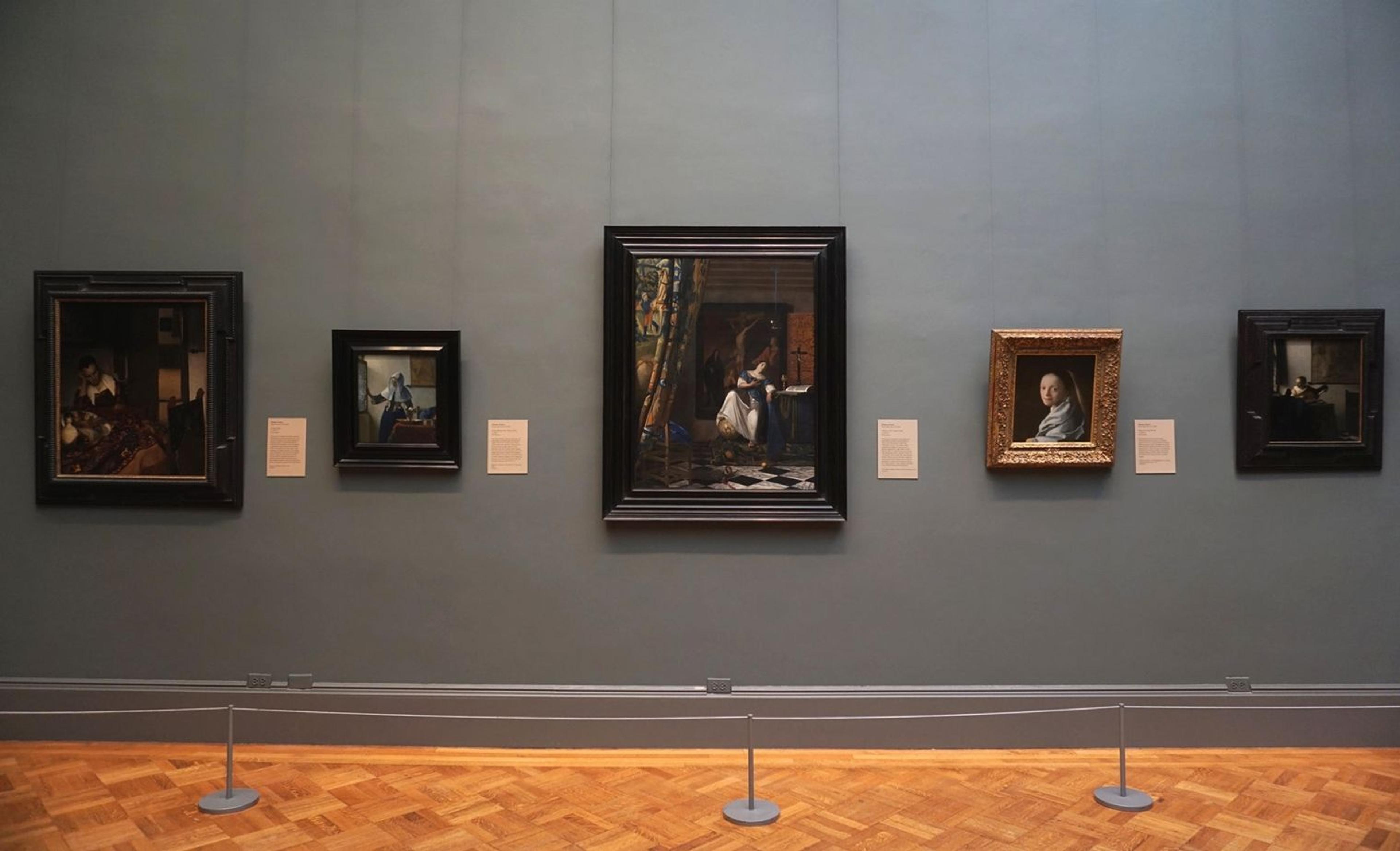A New Look at Vermeer

View of The Met's five Vermeers as installed in gallery 630
By most counts, only thirty-four paintings by Johannes Vermeer survive in the entire world. Of these, five are at The Met, more than at any other museum. The ongoing renovation of the skylights in The Met's European Paintings galleries has necessitated putting many works in storage and placing those that remain on view in condensed installations. From the start of the project, we have been committed to keeping our Vermeers—among the most beloved works in the entire Museum—on public view for the duration of the renovation. In October 2018, four of these pictures will be featured in the exhibition In Praise of Painting: Dutch Masterpieces at the Met (the fifth, Young Woman with a Lute heads to an exhibition in Japan). This summer, however, visitors have the rare opportunity to see all five Vermeers hung in a row on a single wall of gallery 630.
In the previous display, the Vermeers hung on separate walls of the same gallery, strategically placed in dialogue with other examples of "high-life" genre painting by Vermeer's contemporaries. Seeing all of the artist's paintings on a single wall has been a revelation even for those of us who are very familiar with the collection.

Johannes Vermeer (Dutch, 1632–1675). Clockwise from top left: A Maid Asleep, ca. 1656–57. Oil on canvas, 34 1/2 x 30 1/8 in. (87.6 x 76.5 cm). The Metropolitan Museum of Art, New York, Bequest of Benjamin Altman, 1913 (14.40.611). Allegory of the Catholic Faith, ca. 1670–72. Oil on canvas, 45 x 35 in. (114.3 x 88.9 cm). The Metropolitan Museum of Art, New York, The Friedsam Collection, Bequest of Michael Friedsam, 1931 (32.100.18). Study of a Young Woman, ca. 1665–67. Oil on canvas, 17 1/2 x 15 3/4 in. (44.5 x 40 cm). The Metropolitan Museum of Art, New York, Gift of Mr. and Mrs. Charles Wrightsman, in memory of Theodore Rousseau Jr., 1979 (1979.396.1). Young Woman with a Lute, ca. 1662–63. Oil on canvas, 20 1/4 x 18 in. (51.4 x 45.7 cm). The Metropolitan Museum of Art, New York, Bequest of Collis P. Huntington, 1900 (25.110.24). Young Woman with a Water Pitcher, ca. 1662. Oil on canvas, 18 x 16 in. (45.7 x 40.6 cm). The Metropolitan Museum of Art, New York, Marquand Collection, Gift of Henry G. Marquand, 1889 (89.15.21)
These five works represent every stage of Vermeer's career and document his evolution as he gained confidence in the depiction of pictorial space—moving from Maid Asleep, where the figure is anchored in place by the table that juts out of the lower left-hand corner, to the mid-career compositions Young Woman with a Lute and Young Woman with a Water Pitcher, where chairs and tables are set further back from the foreground, offering a bridge into the painting. Finally, in the grandiose Allegory of the Catholic Faith, painted close to the end of the artist's life, Vermeer expands his composition to take in more of the room, placing a full-length figure within the perspectival grid of a checkerboard floor.
The Met's five pictures reveal not only Vermeer's growth as a painter, but also the spectrum of his subject matter. They range from the observation of a single intriguing face, or tronie, in his Study of a Young Woman, to the elaborate symbolism of Allegory of the Catholic Faith, a picture that documents how in touch Vermeer was with the mainstream of Italian and Flemish Baroque art. Recurrent motifs, such as the maps of Europe that appear in in the backgrounds of both Young Woman with a Lute and Young Woman with a Water Pitcher, also become apparent when the paintings are viewed in a single row.

View of three of The Met's Rembrandt paintings as installed in gallery 630
In this gallery, Vermeer's five paintings now "face off" with three of The Met's other great Dutch masterpieces: Rembrandt's Aristotle Contemplating the Bust of Homer, which is flanked by his Man with a Magnifying Glass and its pendant, Woman with a Pink. The latter two pictures are normally displayed with other works from the seminal 1913 bequest of Benjamin Altman, but when arranged as a triptych with Aristotle, they attest to the extraordinary achievement of Rembrandt's late style and its ample representation in The Met's collection. As viewers turn from one wall of masterpieces to another, they may come to understand why Simon Schama titled his famous history of Golden Age Dutch culture The Embarrassment of Riches!
This article was updated on July 5, 2018, to clarify the presence of a map in Young Woman with a Lute and Young Woman with a Water Pitcher as a recurrent motif, not a recurrent prop.
Related Content
View the web feature Met Masterpieces in a New Light for more information about the Skylights Project and explore ways to engage with the Department of European Paintings' collection online.
Read more articles in this Collection Insights blog series.
Read essays related to this topic on the Heilbrunn Timeline of Art History: "Johannes Vermeer (1632–1675)"; "Johannes Vermeer (1632–1675) and The Milkmaid"; "Rembrandt (1606–1669): Paintings."
Adam Eaker
Associate Curator Adam Eaker studied Art History at Yale University and Columbia University, where he received his PhD in 2016. A specialist in Northern European and British painting of the 16th through the 18th century, he was previously a visiting scholar at the Rubenianum Research Institute for Flemish Art in Antwerp. Before joining the staff of The Met, he served as an Anne L. Poulet Curatorial Fellow and subsequently guest curator at the Frick Collection, where he co-curated the exhibition Van Dyck: The Anatomy of Portraiture (2016).